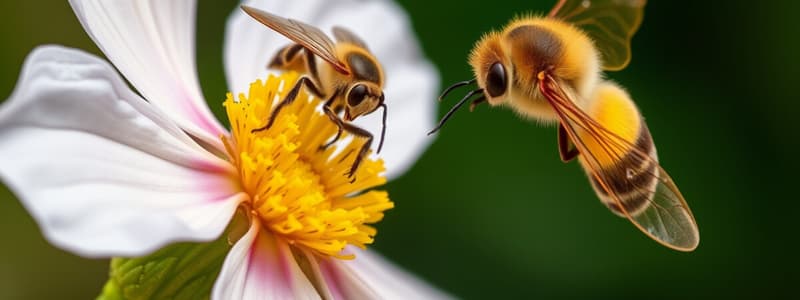Podcast
Questions and Answers
Bees collect ______ from flowers, which they convert into food.
Bees collect ______ from flowers, which they convert into food.
nectar
The relationship between bees and flowering plants is described as ______.
The relationship between bees and flowering plants is described as ______.
mutualistic
Orchids use bizarre devices to mimic the ______ organs of female bees.
Orchids use bizarre devices to mimic the ______ organs of female bees.
sex
Some flowers are shaped and colored like ______ to attract male insects.
Some flowers are shaped and colored like ______ to attract male insects.
The process where a flower deposits pollen on an insect's head is called ______.
The process where a flower deposits pollen on an insect's head is called ______.
Many crops rely on ______ for successful pollination.
Many crops rely on ______ for successful pollination.
Some plants reproduce using ______ in cones or spores instead of flowers.
Some plants reproduce using ______ in cones or spores instead of flowers.
Plants that use wind pollination need adaptations for both releasing and ______ pollen.
Plants that use wind pollination need adaptations for both releasing and ______ pollen.
WIND POLLINATED flowers often have ______ petals, often brown or dull green.
WIND POLLINATED flowers often have ______ petals, often brown or dull green.
Unlike WIND POLLINATED flowers, INSECT POLLINATED flowers usually contain ______.
Unlike WIND POLLINATED flowers, INSECT POLLINATED flowers usually contain ______.
The ______ is feathery or net like in WIND POLLINATED flowers to catch drifting pollen.
The ______ is feathery or net like in WIND POLLINATED flowers to catch drifting pollen.
WIND POLLINATED flowers produce lots of ______ because most does not reach another flower.
WIND POLLINATED flowers produce lots of ______ because most does not reach another flower.
INSECT POLLINATED flowers have ______, brightly coloured petals to attract insects.
INSECT POLLINATED flowers have ______, brightly coloured petals to attract insects.
The anthers of WIND POLLINATED flowers hang ______ the flower to release pollen into the wind.
The anthers of WIND POLLINATED flowers hang ______ the flower to release pollen into the wind.
Pollen of INSECT POLLINATED flowers is often ______ or spiky to stick to insects.
Pollen of INSECT POLLINATED flowers is often ______ or spiky to stick to insects.
In WIND POLLINATED flowers, the stigma hangs outside the flower to ______ the drifting pollen.
In WIND POLLINATED flowers, the stigma hangs outside the flower to ______ the drifting pollen.
The transfer of pollen from ______ to ______ of a flower.
The transfer of pollen from ______ to ______ of a flower.
If this occurs within the same flower it is called _____ pollination.
If this occurs within the same flower it is called _____ pollination.
Flowers attract insects through their ______, scent, and nectar.
Flowers attract insects through their ______, scent, and nectar.
Pollen is left on the stigma because it is ______.
Pollen is left on the stigma because it is ______.
The ______ part of the flower is known as the anther.
The ______ part of the flower is known as the anther.
The ______ part of the flower is known as the stigma.
The ______ part of the flower is known as the stigma.
Insects use ______ as a food source while pollinating.
Insects use ______ as a food source while pollinating.
Female bees have specialized structures called ______ used for storing pollen.
Female bees have specialized structures called ______ used for storing pollen.
Flashcards are hidden until you start studying
Study Notes
Pollination Basics
- Pollination is the transfer of pollen from the anther to the stigma of a flower, crucial for plant reproduction.
- Self-pollination occurs within a single flower, while cross-pollination involves different flowers.
Role of Insects in Pollination
- Bees gather nectar for food, simultaneously picking up and transferring pollen, establishing a mutualistic relationship with flowering plants.
- Pollination by insects benefits many crops and has an economic value worth millions annually.
Unique Adaptations of Flowers
- Orchids mimic female bee sex organs to attract male bees, leading to pseudocopulation that aids pollination.
- Some flowers mimic the appearance and scent of female insects to entice males, facilitating pollen transfer during attempts to copulate.
Wind vs. Insect Pollination
- Wind-pollinated plants often have small, dull petals, no scent or nectar, and produce large amounts of lightweight pollen that can drift in the air.
- In contrast, insect-pollinated flowers feature bright colors, pleasant scents, and nectar to attract pollinators, with sticky pollen that adheres to insects.
Anatomical Features
- Honeybees and bumblebees possess specialized structures called pollen baskets for collecting and transporting pollen back to their nests.
- Bees have combs and brushes on their legs that help in aggregating pollen, which is moistened with honey or nectar for transport.
Structural Differences
- Wind-pollinated flowers rely on external environmental factors for fertilization and lack reliance on insect attraction mechanisms.
- Insect-pollinated flowers are designed to direct pollinators to ensure effective pollen transfer, with sticky stigmas and strategically placed anthers.
After Pollination
- Successful pollination leads to fertilization, enabling plants to reproduce and develop seeds, critical for the continuation of plant species.
Studying That Suits You
Use AI to generate personalized quizzes and flashcards to suit your learning preferences.




